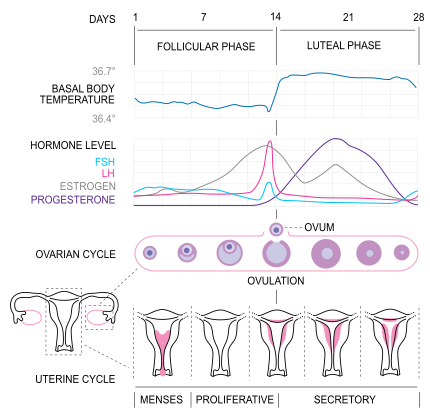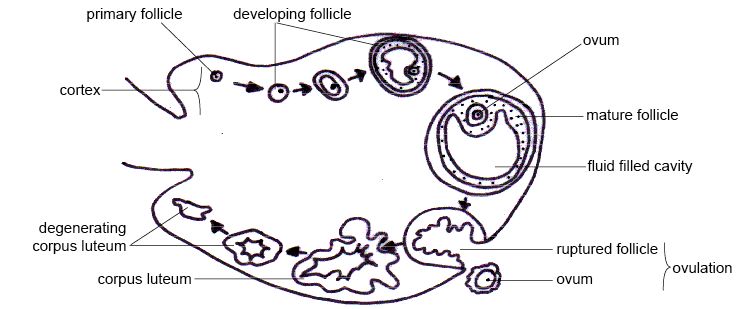7.5 Physiology of the Female Reproductive System
Menstruation (men-strŪ-Ā-shŏn), also called menses, commonly referred to as a woman’s “period,” is vaginal bleeding that occurs as part of a monthly cycle. Every month, the female body prepares for possible pregnancy. If no pregnancy occurs, the uterus sheds the endometrial lining. Menstrual flow is part blood and part endometrial lining that passes out of the uterus, through the cervix, and into the vagina. Menstruation typically starts in females between the ages of 11 and 14 and continues until menopause at an average age of 51. In addition to bleeding, females may experience additional emotional and physical symptoms, which is referred to as premenstrual syndrome (PMS).[1] Premenstrual syndrome (PMS) is discussed in more detail in the “Diseases and Disorders of the Female Reproductive System” section of this chapter.
The Menstrual Cycle
The menstrual cycle is driven by a monthly hormonal cycle as the female’s body prepares an egg for fertilization and possible pregnancy. The menstrual cycle is counted from the first day of a bleeding of one cycle to the first day of the next menstrual cycle. Menstrual flow usually lasts about three to five days. The typical volume of blood lost during menstruation is approximately 30 milliliters (mL). Amounts greater than 80 mL, menstrual flow longer than five days, or bleeding between cycles can be symptoms of a disorder.[2]
The average menstrual cycle takes about 28 days and occurs in three phases, called the follicular, ovulatory, and luteal phases, also referred to as menses, proliferative, and secretory uterine cycles. Hormone levels change throughout the menstrual cycle. See Figure 7.4 for an illustration of the phases of the menstrual cycle.[3]

Follicular Phase
The follicular phase (Fŏl-ĭk-yŭ-lăr fāz), also referred to as the pre-ovulatory or proliferative phase, begins when menstrual flow ceases and the endometrium in the uterus begins to thicken. During the follicular phase of the menstrual cycle, the following events occur[4]:
- Two hormones, follicle stimulating hormone (FŌL-ĭ-kl stim-YŪ-lā-ting HŌR-mōn) (FSH) and luteinizing hormone (LŪ-tē-ĭ-nīz-ĭng HŌR-mōn) (LH), are released from the brain and travel in the blood to the ovaries. These hormones stimulate the growth of ova (eggs) in their own shells called follicles (FŎL-ĭ-klz).
- The FSH and LH hormones also trigger an increase in the production of the hormone estrogen (ĔS-trŏ-jen), which is produced by the developing follicles. As the estrogen level continues to rise, it turns off the production of FSH, like a switch. This careful balance of hormones allows the body to limit the number of follicles to be released.
- As the follicular phase progresses, one follicle in one ovary becomes dominant and continues to mature. This dominant follicle, called the Graafian follicle, suppresses the growth of all other follicles. In addition, this dominant follicle continues to produce estrogen.
Ovulatory Phase
The ovulatory phase usually starts about 14 days after the follicular phase began. During this phase, the following events occur[5]:
- The rise in estrogen from the Graafian (dominant) follicle triggers a surge in the amount of luteinizing hormone (LH) produced by the brain. This surge causes the Graafian (dominant) follicle to release the ovum (Ō-vum).
- When the ovum is released from the follicle, it is referred to as ovulation (ov-yŭ-LĀ-shŏn). The ovum is captured by the fimbriae (FĬM-brē-ā), the finger-like projections on the end of the Fallopian tubes. The fimbriae sweep the egg into the Fallopian tube.
- For one to five days prior to ovulation, many women notice an increase in cervical mucus that looks like egg white. This mucus helps capture and nourish the sperm on the way to meet the egg for fertilization.
Luteal Phase
The luteal (postovulatory) phase begins right after ovulation and involves the following processes[6]:
- After the ovum is released, the empty follicle develops into a new structure called the corpus luteum. The corpus luteum (KŌR-pus LŪ-tē-um) is a temporary, hormone-producing gland involved in ovulation and early pregnancy.
- The corpus luteum secretes estrogen and progesterone (pro-JĔS-tĕr-ōn). Progesterone prepares the uterus for implantation (ĭm-plan-TĀ-shŏn) of a fertilized egg into the uterine lining and is an important hormone during pregnancy.
- If the egg becomes fertilized by sperm, which is referred to as conception (kŏn-sĕp-shŏn), it is referred to as an embryo (Ĕm-brē-ō). The embryo travels through the Fallopian tubes and implants in the endometrial lining of the uterus.
- If the egg isn’t fertilized, it dissolves in the uterus, the endometrial lining breaks down and sheds because it is no longer needed, and menses (bleeding) begins. This is also referred to as the menses or menstrual phase and lasts between 3-5 days. See Figure 7.5[7] for an illustration of the progression of a follicle to a corpus luteum.

View a supplementary MedLine video[8] on ovulation: Ovulation Video
Fertilization, pregnancy, and contraception are discussed in the “Obstetrics Terminology” chapter.
Other Medical Terms Related to the Female Reproductive System
- Adnexa (ăd-NĔK-să): Accessory structures of the uterus, such as the Fallopian tubes and ovaries.
- Amenorrhea (ā-men-ŏ-RĒ-ă): Absence of menstrual flow.
- Anovulation (an-ov-yŭ-LĀ-shŏn): Absence of ovulation.
- Contraception (kon-tră-SEP-shŏn): Intentional prevention of pregnancy.
- Dysmenorrhea (dis-men-ŏ-RĒ-ă): Painful menstrual flow.
- Dyspareunia (dis-pă-RŪ-nē-ă): Painful sexual intercourse.
- Fistula (FIS-chŭ-lă): An abnormal passageway between two organs or an internal organ and the body surface. Although uncommon, a vaginal fistula can develop between the vagina and another organ, such as the urinary bladder, colon, or rectum.
- Infertility (ĭn-fĕr-TĬL-ĭ-tē): The inability to conceive.
- Mastitis (mas-TĪT-ĭs): Inflammation of the breast that tends to occur when a woman is lactating.
- Menorrhagia (mĕn-ō-RĀ-jē-ă): Excessive menstrual bleeding.
- Menometrorrhagia (mĕn-ō-mĕt-rō-RĀ-jē-ă): Excessive and prolonged uterine bleeding occurring at irregular and/or frequent intervals.
- Metrorrhagia (mē-trō-RĀ-jă): Bleeding from the uterus between menstrual periods.
- Menarche (mĕn-ĂR-kē): The first occurrence of menstruation.
- Oligomenorrhea (ŏl-ĭ-gō-mĕn-ō-RĒ-ă): Infrequent or very light menstruation.
- Polymenorrhea (pŏl-ē-mĕn-ō-RĒ-ă): Frequent menstruation in which menstrual cycles are shorter than 21 days in length.
- Sexual intercourse (Sĕk-shū-ăl ĭn-tĕr-kōrs): Sexual contact between individuals that includes insertion of a penis into a vagina.
- Tubal ligation (TOO-băl lī-GĀ-shŏn): Surgical closure or blocking of the Fallopian tubes to prevent pregnancy; also referred to as sterilization.
- Anatomy & Physiology by OpenStax is licensed under CC BY 4.0. Access for free at https://openstax.org/books/anatomy-and-physiology/pages/1-introduction ↵
- Anatomy & Physiology by OpenStax is licensed under CC BY 4.0. Access for free at https://openstax.org/books/anatomy-and-physiology/pages/1-introduction ↵
- “MenstrualCycle2_en.svg.png” by Isometrik is licensed under CC BY 3.0 ↵
- Cleveland Clinic. (2022, November 28). Female reproductive system. https://my.clevelandclinic.org/health/articles/9118-female-reproductive-system ↵
- Cleveland Clinic. (2022, November 28). Female reproductive system. https://my.clevelandclinic.org/health/articles/9118-female-reproductive-system ↵
- Cleveland Clinic. (2022, November 28). Female reproductive system. https://my.clevelandclinic.org/health/articles/9118-female-reproductive-system ↵
- “Anatomy_and_physiology_of_animals_Ovarian_cycle_showing_from_top_left_clockwise.jpg” by Sunshineconnelly at English Wikibooks is licensed under CC BY 3.0 ↵
- A.D.A.M. (2022, January 10). Ovulation [Video]. Medline Plus. https://medlineplus.gov/ency/anatomyvideos/000094.htm ↵

